
Caracas, officially Santiago de León de Caracas (CCS), is the capital and largest city of Venezuela, and the center of the Metropolitan Region of Caracas. Caracas is located along the Guaire River in the northern part of the country, within the Caracas Valley of the Venezuelan coastal mountain range. The valley is close to the Caribbean Sea, separated from the coast by a steep 2,200-meter-high (7,200 ft) mountain range, Cerro El Ávila; to the south there are more hills and mountains. The Metropolitan Region of Caracas has an estimated population of almost 5 million inhabitants.

Balderas is an underground station on the Mexico City Metro. It is located in the Cuauhtémoc borough in the center of Mexico City. It is a transfer station along Lines 1 and 3. Since 9 November 2023, the Line 1 station has remained closed for modernization work on the tunnel and the line's technical equipment. The Line 1 station was reopened in September 13, 2024.

The Caracas Metro is a mass rapid transit system serving Caracas, Venezuela. It was constructed and is operated by Compañía Anónima Metro de Caracas, a government-owned company that was founded in 1977 by José González-Lander who headed the project for more than thirty years since the early planning stages in the 1960s. Its motto is "Somos parte de tu vida". In 1978 MTA – New York City Transit's R46 #816 was shipped from the Pullman Standard's plant as a sample of rolling stock to be used for the new metro system that was under construction at the time.

The Mexico City Metro is a rapid transit system that serves the metropolitan area of Mexico City, including some municipalities in the State of Mexico. Operated by the Sistema de Transporte Colectivo (STC), it is the second largest metro system in North America after the New York City Subway.

La Raza metro station is a Mexico City Metro transfer station in the Gustavo A. Madero borough of Mexico City. It is a combined underground and at-grade station with two side platforms each, served by Lines 3 and 5. La Raza metro station is located between Potrero and Tlatelolco stations on Line 3, and between Autobuses del Norte and Misterios stations on Line 5. It serves the colonias (neighborhoods) of Vallejo and Héroes de Nacozari. The station's pictogram depicts the nearby Monumento a la Raza, a pyramid-shaped construction erected in honor of la Raza, Mexico's many native peoples and cultures.

Indios Verdes metro station is a station of the Mexico City Metro along Insurgentes Norte Avenue in the colonias (neighborhoods) of Residencial Zacatenco and Santa Isabel Tola, in Gustavo A. Madero, Mexico City. It is an at-grade station with two island platforms that serves as the northern terminus of Line 3. It is followed by Deportivo 18 de Marzo station. The station and its surrounding area are named this way because of the verdigris statues of Itzcoatl and Ahuitzotl, both Aztec rulers. They are located in Mestizaje Park and are collectively known as the Monumento a los Indios Verdes; the silhouettes of the statues are depicted in the pictogram. The station was opened on 1 December 1979, on the first day of service between Indios Verdes and Hospital General stations.
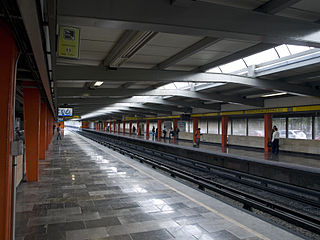
Instituto del Petróleo metro station is a Mexico City Metro transfer station in Gustavo A. Madero, Mexico City. It is a combined underground and at-grade station with two side platforms each, along Lines 5 and 6. Instituto del Petróleo metro station is located between Politécnico and Autobuses del Norte stations on Line 5, and between Vallejo and Lindavista stations on Line 6. It serves the colonias (neighborhoods) of Valle del Tepeyac, San Bartolo Atepehuacan, and Nueva Industrial. The station's pictogram depicts an oil derrick, and its name is on account of its proximity to the Mexican Petroleum Institute headquarters.

The State Railways Institution is a state-run organization of Venezuela that manages the railway systems of the country. Its headquarters are located in Caracas, Venezuela.
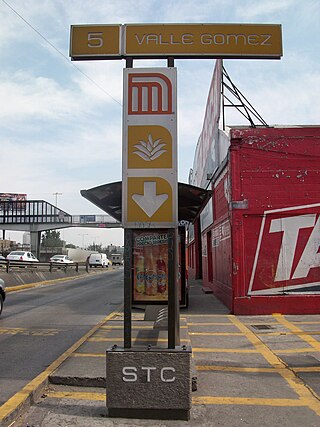
Valle Gómez metro station is a Mexico City Metro station within the limits of Gustavo A. Madero and Venustiano Carranza, in Mexico City. It is an underground station with two side platforms, served by Line 5, between Misterios and Consulado stations. Valle Gómez station serves the colonias of 7 de Noviembre and Valle Gómez; the station receives its name from the latter. The station's pictogram features an agave plant. Valle Gómez metro station was opened on 1 July 1982, on the first day of the La Raza–Pantitlán service. In 2019, the station had an average daily ridership of 4,416 passengers, making it the 190th busiest station in the network and the least busy of the line.

The Panama Metro is a rapid transit system in Panama City, Panama. It links neighborhoods north and the east of the metropolitan area to the city center.

Ciudad Universitaria is a Caracas Metro station on Line 3. It was opened on 18 December 1994 as part of the inaugural section of Line 3 from Plaza Venezuela to El Valle. The station is between Plaza Venezuela and Los Símbolos.
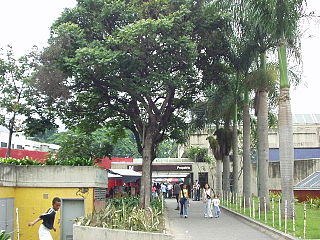
Propatria is a Caracas Metro station on Line 1. It was opened on 2 January 1983 as part of the inaugural section of Line 1 between Propatria and La Hoyada, and is located on Avenida 2 de Propatria. It serves as the western terminus of the line. The following station is Pérez Bonalde. Trains run from the station every three minutes.
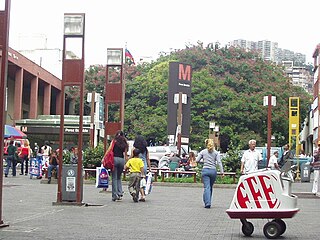
Pérez Bonalde is a Caracas Metro station on Line 1. It was opened on 2 January 1983 as part of the inaugural section of Line 1 between Propatria and La Hoyada, and is on Catia Boulevard. The station is between Propatria and Plaza Sucre.
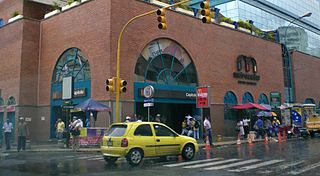
Capitolio is a Caracas Metro station on Line 1. It was opened on 2 January 1983 as part of the inaugural section of Line 1 between Propatria and La Hoyada. The station is between Caño Amarillo and La Hoyada. It is a transfer station, connected with Line 2 via El Silencio. The station is located at the corner of Avenida Universidad and Avenida Baralt.

La Paz is a Caracas Metro station on Line 2. It was opened on 4 October 1987 as part of the inaugural section of Line 2 from La Paz to Las Adjuntas and Zoológico. The station served as the northern terminus of Line 2 until 6 November 1988, when the line was extended to El Silencio. The station is between Artigas and La Yaguara.
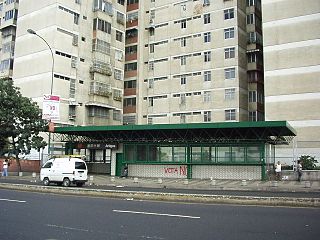
Artigas is a Caracas Metro station on Line 2. It was opened on 6 November 1988 as part of the extension of the line from La Paz to El Silencio. The station is between Maternidad and La Paz.

Maternidad is a Caracas Metro station on Line 2. It was opened on 6 November 1988 as part of the extension of the line from La Paz to El Silencio. The station is between Capuchinos and Artigas.

Capuchinos is a Caracas Metro station on Lines 2 and 4. The Line 2 station was opened on 6 November 1988 as part of the extension of the line from La Paz to El Silencio station. The station is between El Silencio and Maternidad.
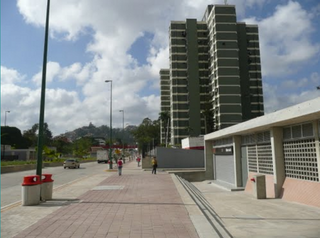
Mercado is a Caracas Metro station on Line 3. It was opened on 9 January 2010 on the section of the line between El Valle and La Rinconada, which started operations earlier without intermediate stations. The station is located between Coche and La Rinconada.



















